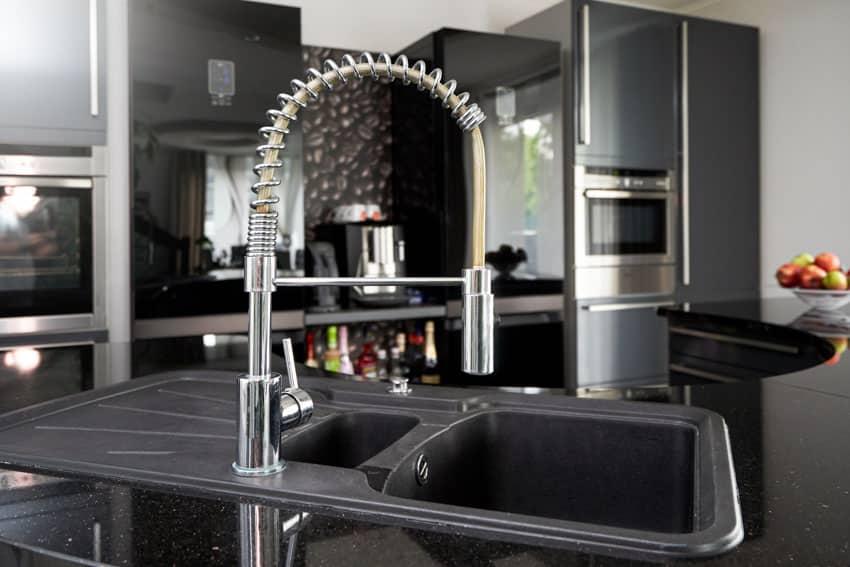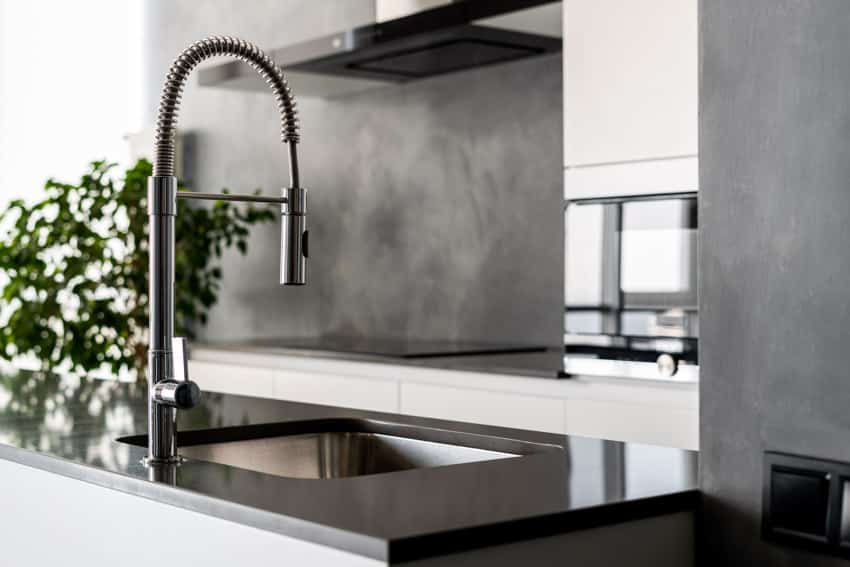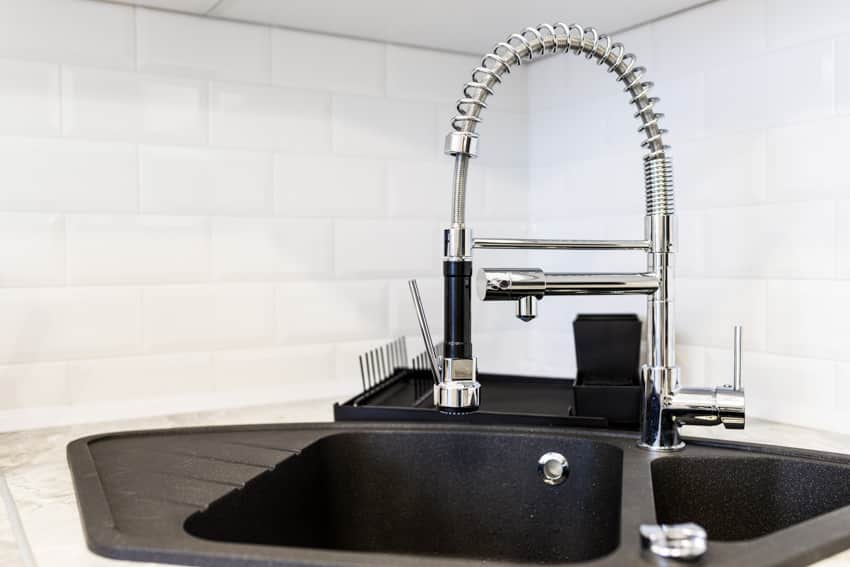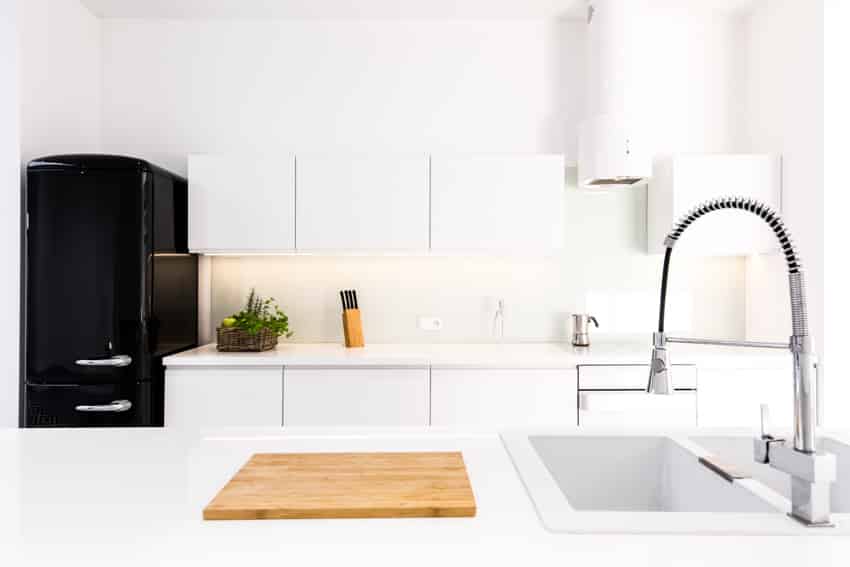Here we share our pros and cons of touchless kitchen faucets including how they work, cost, reliability, durability and if a touchless faucet is worth it for your home.
Touchless kitchen faucets have always been a staple in restaurants and other commercial establishments. However, they have started trending in the residential scene as well. These faucets are also at times nicknamed as automatic faucets.
You are watching: Pros And Cons Of Touchless Kitchen Faucets
And when you come to think about it, the concept of touchless kitchen faucets definitely makes a lot of sense. It’s a way for you to turn the water on and wash dirt off of your hands without ever having to get the actual hardware dirty. This can be quite handy in the home.
These faucets work off of a sensor that gets activated by minor movements such as a slight tap. There are sensors embedded in the spout and in the handle of the faucet, triggering the mechanism to turn it on and let the water flow. They can either turn off automatically after a pre-set amount of time or they can be turned off with another quick tap.
How Do Touch Faucets Work

A traditional faucet also has sensors although what makes the touchless ones stand out is that more than half of the technology is equipped with a detector. A touchless faucet’s detector is activated through motion whereas a traditional faucet is activated by touch.
The sensors can either be via ultrasonic sensor or via infrared light. The sensor of a touchless faucet is either at its side or at the front of its body. There have been some touchless faucets, however, that have the sensor hidden at the back of the spout.
The science behind how touchless faucets work is pretty simple. It works with a function called capacitive sensing. It’s triggered by a small electrical charge when your hand taps on it. The typical human body holds out a charge called a “capacitance”.
It measures at a range of 100 to 200 picofarads. The sensors in the touch faucets are built to detect such a capacitance. Touching it turns the water on, touching it again turns it off.
Touchless Pros

Conserves water: This allows you as a homeowner to save money because of reduced water bills over time. The simple act of washing your hands in the sink can consume around 2 gallons of water per minute. Kids can end up stepping away from a faucet without turning it off.
There will also be instances wherein someone in your household may leave the faucet running for a myriad of reasons. This isn’t a problem you’ll be having with touchless faucets since those can sense when it isn’t being used, turning the water off automatically. These little amounts of water saved per instance can accumulate over a period of time, resulting in substantial savings.
Sanitary: Traditional types of kitchen faucets can end up being a hot spot for dirt, grime, and even germs and bacteria. This is especially true if they aren’t being cleaned often. Washing your hands or dealing with raw food items could leave residual particles on the handles.
This can contaminate food and other items around the kitchen. Touchless faucets turn on without ever making contact with your possibly contaminated hands. This prevents the spreading of germs and bacteria, ensuring your kitchen is sanitary.
Convenient: Touchless faucets provide easy access to water. All you really need to do is to get your hand close enough to it to activate the sensor and the faucet turns on automatically. It then turns off the moment that you’re finished.
They can be found in a lot of modern kitchen designs and they very rarely cause leaks. This means that they can also be very low maintenance.
You also get to have way more control over the temperature of the water as well as the strength of its flow. You can turn it on even while handling large bowls or pots that you need to fill without ever lifting a finger. It makes it convenient and more time efficient when you’re in the process of preparing your meals. Read more about pot filler faucets on this page.
Usability: These faucets are very accessible for those with disabilities, limited mobility and children. The child-friendly features also have the added benefit of encouraging hand washing since they can be fun to use.
Touchless Cons

Breakdowns can be problematic: Touchless faucets are usually comprised of more mechanical parts. This means that in the event of a malfunction, they can turn out to be more complicated to fix compared to a regular or traditional faucet.
Higher upfront cost: These faucets are typically more expensive than touch faucets. They also can cost more to maintain as they are motion sensor activated. This can lead to sensor malfunction which could lead to costly repairs and possible water loss. Read more about touch vs touchless faucets here.
Sensitivity Problems: The activation sensors can be accidentally tripped, causing water flow when not needed.
Battery Replacement: When the batteries run out they can cause a maintenance inconvenience.
Control of the Temperature: Many faucet products do not provide control over temperature without using a manual adjustment.
Touchless Style Faucet Cost

Apart from the pros and cons of touchless kitchen faucets, homeowners will also have to consider the cost. It depends on the type of touchless kitchen faucet you get. The price can vary depending on the model as well as on the quality of the faucet hardware that it can come with.
Read more : Kitchen Faucet Price & Cost Guide
The price range is typically at around a starting rate of $400 but it can go up depending on how sophisticated the design is and on the quality of the materials it can be made of.
You also need to make sure that you get to factor in the installation along with the cost. For a kitchen installation, depending on the area you’re in, it can be around $250 or so but the cost may be higher in the bigger cities or in the more urbanized areas.
Are Touchless Models Reliable?

Reliability is among the factors that should be considered when assessing the pros and cons of touchless kitchen faucets. They are reliable for as long as they’re made out of high-quality and durable materials.
They can also turn out to be more reliable when they’re maintained periodically. When shopping around for great touchless faucets that you can really rely on, make sure that you take some time to go over the consumer reviews.
Read up on them and compare them in detail. It’s good to take note of the number of sensors it has, how sensitive those said sensors are, and how accurately they actually function.
Another thing to factor in on its reliability is the type of power source that they run on. The four most common power sources for touchless faucets are via battery power (usually lithium batteries), turbine power, solar power, or even hardwired and plugged into the home’s power grid.
How Long Do Touchless Sink Faucets Last?

The most common types of touchless faucets are powered by lithium batteries. These types of batteries enable the uniform or even release of energy to power the faucets.
This guarantees a longer battery life span. Battery life spans can vary greatly depending on the frequency of use, among other things. But on average, they can run on for a good 2 years or so, a detail that should be considered along with the pros and cons of touchless kitchen faucets above.
Do Touchless Fixtures Need Electricity?

The answer to this is yes. Touchless faucets do require being hooked up to the electricity grid for them to run continuously. Touchless faucets will usually require some sort of power source for them to run on.
This power source is meant to control the sensors along with the rest of its other solenoid valves. This can oftentimes run on either electricity, such as AC transformers, or some sort of battery, typically lithium.
One thing that’s a little interesting about touchless faucets though is that even without running the hot water, you’ll notice that they will still continue to run on just fine. Even in the event of a power outage, your touchless faucets will still continue to work.
They will run on cold water for as long as they stay continuously connected to your local water source or supply. If your home is the type that runs water by getting an electric pump drawn out of a deep well though, you lose access to water temporarily so this is something that you ought to be informed about at the end of the day.
Another option that can power up your touchless faucets is through solar power. Artificial light or even natural light can enter the sensors installed in the faucets and get them converted into electrical energy.
Most of the solar-powered touchless faucets out there might still require some sort of backup power source though, such as batteries compatible with solar power. The usage of the battery backup may vary greatly depending on the frequency of the faucet’s use as well as the light conditions inside the kitchen.
And because of the fact that the faucet’s mainstay energy source is light, what this technically means is that the batteries for these said faucets don’t have to be replaced as frequently as you might think.
Another type of touchless faucet can run off of turbine power, too. This is the type that’s actually running based on the mere force of the water supply. How this works is that the running water spins the turbine installed in it, creating electrical energy during the process.
This energy then takes care of running the faucet as well as recharging the backup batteries while it’s at it. In a location as busy as a household’s kitchen, the backup battery may never even get used up.
Do Touchless Products Have Batteries

The short answer to this is yes. Although the concept is that most touchless faucets run on electrical power, the reality is that they will still need to have some sort of backup source for when the main power source runs out.
Hence, the need for batteries. This detail is among the factors to be considered, along with the pros and cons of touchless kitchen faucets above.
This will enable them to continue running in the event of an outage or in the event that there isn’t enough light source to keep them running. The batteries can oftentimes be changed or replaced.
This all depends on the brand of touchless faucet you actually get your hands on in the first place. Some touchless faucets will have the battery pack right beneath the kitchen sink. You just need to pop the lid open once you find the battery box, remove the old ones, and replace it with new ones.
Make sure that the cable will always turn out to be free from cables and other similar obstructions. Also, make it a point to take note that you’re putting in the new batteries with the correct type polarity in mind or it won’t end up working.
Read more : Behind the Scenes: Life on Hell’s Kitchen
It’s simple enough and you only need to look out for the positive and negative signs on both the battery box as well as on the actual batteries you’re installing. They can run on either 4AA or 6AA batteries.
Other more complex faucet types will require you to use a screwdriver to get the battery box removed from its mounting screw. You will need to get the holder wire disconnected from the power wire that’s connected to the faucet’s valve box.
There’s usually some sort of green wire that you will have to disconnect before you get the battery box removed. You can then replace the batteries, reinstall the box, and reconnect the green wire while you’re at it. These types of battery-operated faucets usually run on AAA batteries.
Can A Faucet That Is Touchless Work Manually?

Yes, they can. Touchless faucets are fairly versatile that way. They can still function as regular faucets should you so choose, but it also depends on whether the faucet you have in your kitchen comes with a manual tap.
In general, there’s usually a way for you to disable the sensors that are installed and you can opt to get the mechanism controlled manually.
If you would like to go ahead and override a touchless faucet, all you need to do is to start off by looking for the valve box that’s right under the sink. You will usually need to use some sort of coin so that you can turn the bypass valve in a counterclockwise direction. This will allow you to operate the touchless faucet manually. Turn it clockwise to get it to work automatically again.
For front sensors: Turn the handle on (AKA pulled away from the faucet), then make sure that you use your hands to cover both front sensors for about 5 seconds.
The blue light will blink, indicating that the front sensors have now been disabled. Once it has been deactivated, turn it off by pressing the handle in (towards the touchless faucet).
For both sensors: Pull the handle away from the faucet, use your hands to cover the sensors for about 10 seconds or so. The blue light will start to blink indicating that both sensors have now been finally disabled. Once they’re disabled, repeat the process mentioned above and press the handle in again towards the touchless faucet.
How Do You Control The Temperature?

The most important thing you first need to figure out to get this done is to find out what type of model you have for your touchless faucet. The temperature for these faucets can usually be controlled either by the handle or a separate unit to control it.
In some models, you will just need to get the handle turned while it’s in the “on” position. This will allow you to effectively control the temperature. In some older models of touchless faucets, you will oftentimes be required to get a dial turned.
This can usually be found in a control box that’s found under a sink. Here are some of the parts you need to get acquainted with if you want to control the water temperature on your touchless faucet:
Control box: This takes care of mixing the cold and hot water and is also oftentimes equipped with 4 types of hoses to effectively mix the water temperature. It houses the temperature control valve. It’s automatic and allows you to run it hands-free.
Motion sensor: This uses the same technology employed by smartphones. It connects to the control box mentioned above and is usually located beneath the sink. It’s equipped with an infrared light that detects it when something is placed right underneath it.
When this is triggered, the electronic control valve will then work on regulating the water temperature. Most touchless faucets come with multiple motion sensors.
Electronic control valve: This is where the magic of hands-free operation happens. In most of the older models, they can be controlled by a dial. This dial can also be found beneath the sink.
Newer models of touchless faucets allow you to control the temperature by putting the handle in the off position, or with the handle being away from the faucet.
Thermostatic mixing valve: This mechanism prevents the growth of bacteria as well as scalding in the water temperature. They can be installed directly on the faucet fixture or on the water heaters you’re using at home.
The water’s temperature needs to be at 140 degrees in order for it to kill any water-borne bacteria. This can be scalding on the skin though. A more tolerable temperature would be 120 degrees.
Are Touchless Type Faucets Worth It?

Yes, they are. Even with all the different pros and cons of touchless kitchen faucets, these fixtures are definitely well worth it.
If you want water that’s constantly available on demand with no messes and no hassles, they’re definitely the types that can be vouched for. You get to save over 700 gallons of water per year with the use of a touchless faucet.
This is considerable when you calculate the utility bills that rack up over a period of time. On top of that, you’re helping out the environment by conserving your water usage without having to do anything special.
It’s actually more sanitary since they reduce germs and kill most water-borne germs and bacteria or even those that can accidentally stay on the hardware by way of raw food and other similar substances common in the kitchen.
See more related content in our article about the different types of bathroom faucets on this page.
Source: https://gardencourte.com
Categories: Kitchens


